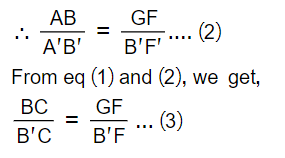 Short Answer Type
Short Answer TypeIn a single slit diffraction experiment, the width of the slit is made double the original width. How does this affect the size and intensity of the central diffraction band ? Explain.
When a tiny circular obstacle is placed in the path of light from a distant source, a bright spot is seen at the centre of the obstacle. Explain why
Obtain the mirror formula and write the expression for the linear magnification.
A relationship among the object distance (u), the image distance (v) and the focal length (f) of a mirror are called the mirror formula.
The formula is given by 
Another ray AE which is passing through C comes back along the same path after reflection.
These two reflected rays intersect at A'. A' draw perpendicular A'B' on the principal axis. So A'B' is a real and inverted image which is formed between C and F which is smaller than the object in size.
Draw DG perpendicular to the principal axis. So, applying sign convention, we get
PB = - u,
PB' = -v
PF = -f
PC = -2f
Now, In △ABC and △A'B'C, ∠ABC =∠A'B'C = 90°
∠ACB = ∠A'CB' (Vertically Opposite angles)
∴ △ABC ~△A'B'C (AA similarity)

![]() (the corresponding side of similar triangles are in proportion)..... (1)
(the corresponding side of similar triangles are in proportion)..... (1)
In △DGF and △A'B'F, ∠DGF = ∠A'B'F = 90°
∠DGF= ∠A'FB' (vertically opposite angles)
△DGF ~△A'B'F (AA similarity)
![]() (corresponding sides of similar triangles are in proportion)
(corresponding sides of similar triangles are in proportion)
But AB = DG (the perpendicular distance between two parallel lines are equal)

Let us assume the mirror is very small,
∴ G and P are very close to each other so that GF = PF.
From equation (3),

If the mirror is plane, the size of the image is always equal to the size of the object i.e., magnification is unity. But the case is different for a curved mirror. The size of the image is different from the size of the object in such a 'mirror'. The image may be greater or smaller in size than the object depending upon the nature of the mirror or the location of the object.
Let I and O be the size of the image and the object respectively. The ratio I/O is called magnification, and it is denoted by m.
Magnification, m = I/O = -v/u
This is called linear magnification.
